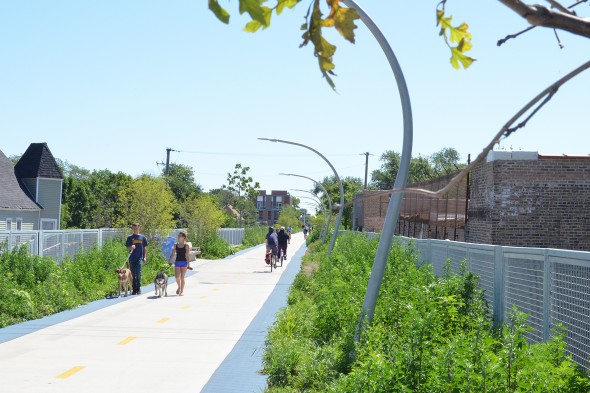Benefits of Chicago’s new 606 Trail more than just exercise

A UIC College of Nursing survey finds the Chicago 606 Trail reduces stress and strengthens sense of community for users. Photo: Fabio Castellon
UIC nursing students and professors have been stopping Chicagoans in their tracks to study the health effects of the new 606 Trail.
They found that regular users of the trail are getting exercise — and strengthening their sense of community.
“There’s growing evidence that the environment affects your health,” said Shannon Zenk, associate professor of health systems science and principal investigator for the study.
The 606 Trail, also called the Bloomingdale Trail, runs along former industrial rail corridors for 2.7 miles between Ashland Street and Ridgeway Avenue on the Northwest Side. The first phase of the $95 million project opened June 6. When completed, the 606 will connect the Logan Square, Humboldt Park, Bucktown and Wicker Park communities.
Students from the College of Nursing stopped adult trail users in 13 different locations and asked them to take a short survey, available in English and Spanish, about their 606 experience.
“In July, one in four of trail users were using the trail at least four times a week, and nearly half said they were exercising more,” Zenk said. “That all sounds good in terms of the trail’s potential to increase physical activity.”
The study also found that the trail helps users reduce stress and strengthen social ties and relationships within the community.
“One in three people use the trail to participate in or feel connected to their community or to socialize, and over 40 percent said they used it to visit a new area,” Zenk noted.
Concerns: safety, lack of restrooms
The survey also found common concerns among trail users, including the potential rise in housing prices near the trail, lack of restrooms and user safety.
“We think those are important findings, and those are areas that should be addressed,” Zenk said.
Zenk presented the findings at the annual meeting of the American Public Health Association Nov. 2 in Chicago.
The team will share their results with the Chicago Park District, the Trust for Public Land, local community groups, residents and agencies. They plan to continue the survey next year, adding observational data about the trail and trail users.
Stephanie Tiwari, nursing student and the study’s research assistant, said she hopes their findings make a difference.
“We really hope that our data can show the importance of this trail and that it also emphasizes the importance of green spaces.”
